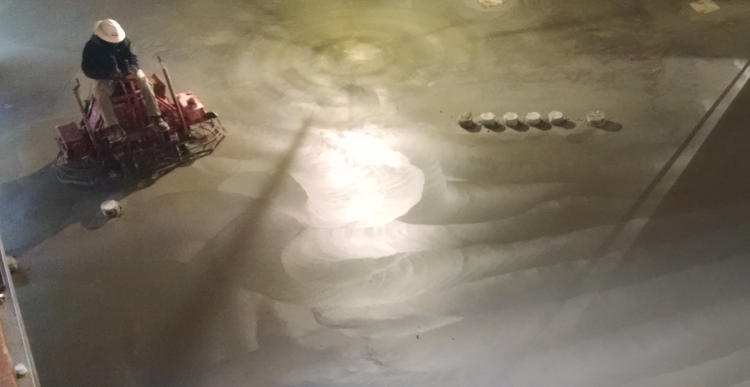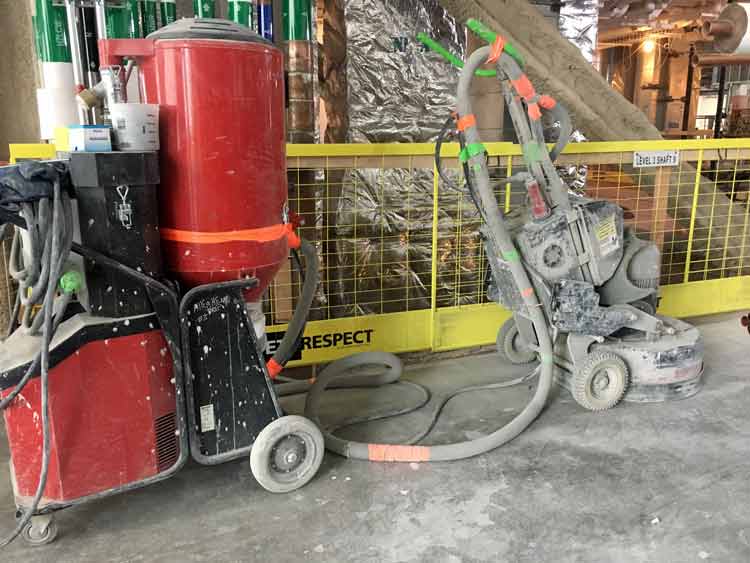Concrete is well-known as a versatile construction material, used worldwide a myriad number of residential commercial and industrial applications. Concrete carries its strength on the inside, but its beauty on the outside: this exterior appearance can be modified by use of various materials and techniques which will be described below.
Concrete Finishes
The most basic type of concrete finish is a smooth surface created through the use of screeds and trowels. Immediately after concrete has been placed in forms, concrete finishers utilize a screed to level out the concrete surface. Screeds often consist of long pieces of metal or wood that are pulled and pushed across the concrete surface to remove excess concrete and fill in gaps in the concrete surface.
Troweling or Floating
Once the concrete has been tooled with a screed, concrete finishers utilize trowels to smooth and fine-level the surface of the concrete. This can be accomplished through manual or mechanical means. To smooth concrete manually a hand trowel, which is typically composed of a flat steel blade with attached handle, is pushed and pulled across the concrete surface. Power trowels are available and are typically used on large commercial and industrial projects where using hand trowels is not feasible. Power trowels resemble large fans with the blades sitting directly against the concrete. These power trowels are available in both walk behind and riding versions.
The image below shows an operator riding a power trowel, which is working to smooth the concrete floor surface.

Edging
Edging of the concrete is conducted to provide rounded or beveled edges on the finished concrete as well as to create joints where needed in the surface to help minimize cracking. A specific edging tool is used to accomplish this task, and requires quite a bit of practice to master.
Broom Finish
In order to make concrete surfaces slip resistant, a broom finish can be applied. This is done after placement, leveling, and troweling of concrete. Once a smooth surface has been created, a broom is dragged across the surface of the concrete to create small ridges that provide for traction control, particularly when the concrete surface is wet. Concrete surfaces without a broom finish tend to be slippery and dangerous when liquids are present on the surface.
Concrete Texture
Aside from broom finishing, there are several other means of creating textures on the surface of concrete, some of which are listed below.
Exposed Aggregate Finish
An exposed finish, once commonly found in sidewalks of old cities, is created by washing the top layer of concrete away, which exposes the edges of the natural stone aggregates that are mixed into the concrete. This provides an attractive and slip resistant finish.
In addition to the use of the normal concrete materials (cement, sand, gravel and water), other materials may be added into the mix to provide exposed finishes with unique looks. Examples are rose quartz, limestone, dark gray or black basalt, red or blue granite and even colored glass or seashells. The key with any of these additives is to avoid materials containing iron, which can stain the concrete. Also, it’s important to provide a high-quality seal after concrete curing in order to protect the surface.
Salt Finish
A salt finish is a type of finish used mainly for swimming pool decks. Salt finishes are created by applying rock salt to the top of the wet concrete and then washing it away, which leaves small pits in the finished surface.
Stamped Concrete
A common method of texturing is to use concrete stamps. Concrete stamps are comprised of panels with inlaid designs, which are placed on concrete while it is still curing. Designs may consist of brick, stone or other decorative patterns to provide the desired look, sometimes mimicking other common building materials, but retaining the strength and durability of concrete. Once the forms are removed, the concrete surface may have color applied via staining, as described below.
Concrete Coloring
Concrete have color added to provide a look that fits with the architecture of the associated structure. This can be accomplished through mix-added pigments or post-cure staining, both of which are discussed below.
Concrete Pigments
Concrete coloring using pigments is a simple process, accomplished by adding the pigments directly to the concrete mix prior to pouring. Pigments are available in liquid form or in “mix-ready” dissolvable bags. In both cases, the pigments are placed in the mixer with the other concrete ingredients. The range of colors available is typically confined to “earthy” variants of browns and tans, although greens, blues and grays can also be purchased. It is important to keep pigmented concrete well sealed throughout its lifetime in order to prevent water infiltration, which may cause the pigment to fade.
Concrete Stain
The color of concrete can also be manipulated through the use of various staining products. One common method of staining concrete is through the use of acid. Similar to concrete pigments, the range colors is typically confined to non-bright, relatively subtle tones. Water-based (acrylic) staining provides for a much larger number of colors, including black and white. Stains can be applied to concrete of any age, though the colors are typically more vibrant if the stain is applied relatively soon after the concrete has been placed. Application of stain is typically followed up with installation of a seal over the concrete to protect the surface.
Polished Concrete
Cured concrete, whether freshly-placed or well-aged, can be provided with a polished surface for a clean and glossy look, ease of maintenance and a surface that provides additional slip resistance over that of non-polished concrete.
The polishing process is typically accomplished using concrete floor grinders that are outfitted with diamond abrasives. The grade of the abrasives, from coarse to fine, will determine the final smoothness of the concrete surface at the completion of the polishing process. First, concrete is stripped of any existing sealer or coatings and any visible cracks are repaired. This is followed by the polishing process using the floor grinders mentioned above. Part way through the polishing process, chemical hardeners are often added to the concrete to provide future protection against water infiltration. Finer and finer abrasives are used until the desired surface finish is achieved. If desired, the final step involves application of a sealing product to protect the concrete from oil, chemicals, staining and moisture.

It is important that the contractor properly protect polished concrete both before and after polishing. Stains from oils, standing water, or other debris generally cannot be removed during the polishing process. Likewise, any damage that occurs after the polishing is complete is hard to repair without there being an obvious patch.


